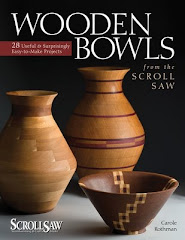
When I start moving from basic bowls to more elaborate projects, I studied segmented bowls, made on the lathe, to get some ideas. What I noticed, consistently, was the use of veneer to set off decorative rings. Although not cheap, veneer is less expensive than thin wood, and can sometimes be obtained in thicknesses as great as 1/16". For the new box book, I experimented with dyed colored veneer, and was very pleased with the results. It works similarly to padauk, or any other wood that can bleed if you're not careful, but otherwise presents no special problems.
Constantines, located in Ft. Lauderdale, FL, is a reliable source for specialty veneer, as well as other interesting stuff. I visited their store last summer, and was impressed with their stock. I was sorely tempted by a beautiful piece of bird's eye maple veneer, dyed a gorgeous blue, but could not think of a way to use it. Of course I'm sorry now to have passed it up. They pack the veneer carefully, so mail order is not a problem.
Since they're a small outfit, they are responsive to special requests, and seem to choose their stock carefully. If you're looking for a way to make your projects stand out, give veneer a try.





